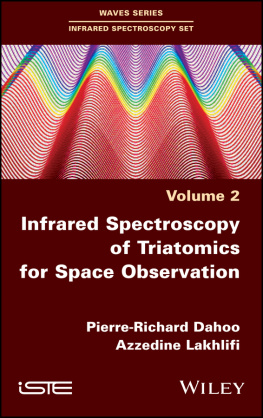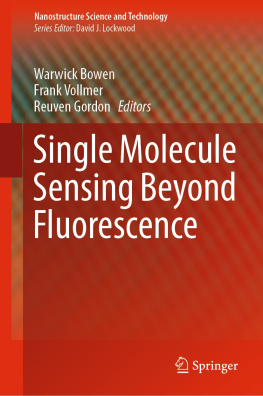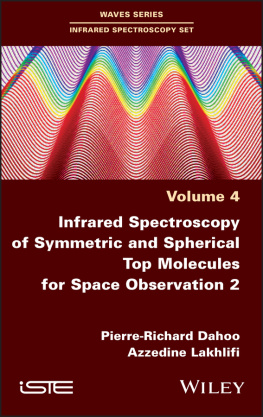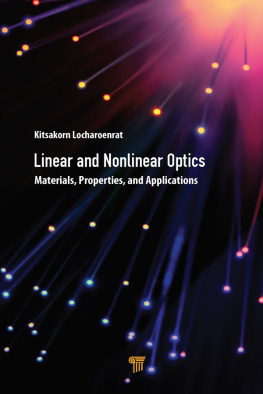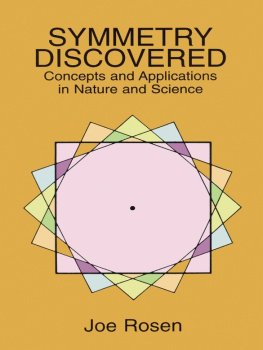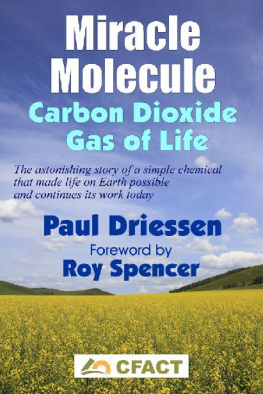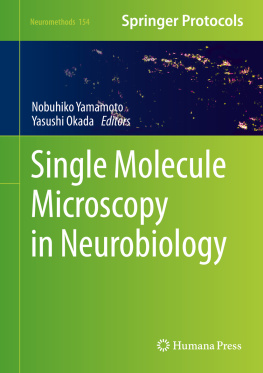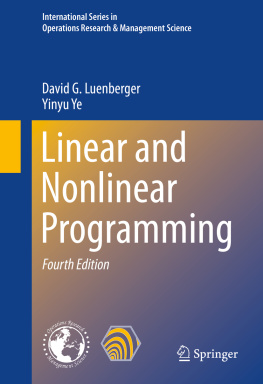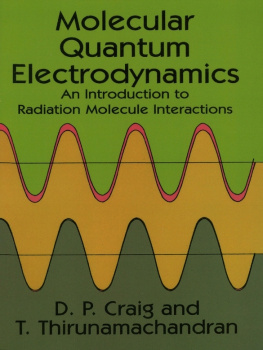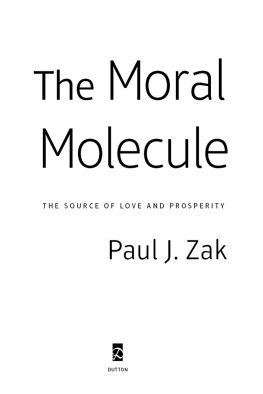
Infrared Spectroscopy Set
coordinated by
Pierre Richard Dahoo and Azzedine Lakhlifi
Volume 2
Infrared Spectroscopy of Triatomics for Space Observation
Pierre Richard Dahoo
Azzedine Lakhlifi

First published 2019 in Great Britain and the United States by ISTE Ltd and John Wiley & Sons, Inc.
Apart from any fair dealing for the purposes of research or private study, or criticism or review, as permitted under the Copyright, Designs and Patents Act 1988, this publication may only be reproduced, stored or transmitted, in any form or by any means, with the prior permission in writing of the publishers, or in the case of reprographic reproduction in accordance with the terms and licenses issued by the CLA. Enquiries concerning reproduction outside these terms should be sent to the publishers at the undermentioned address:
ISTE Ltd
2737 St Georges Road
London SW19 4EU
UK
www.iste.co.uk
John Wiley & Sons, Inc.
111 River Street
Hoboken, NJ 07030
USA
www.wiley.com
ISTE Ltd 2019
The rights of Pierre Richard Dahoo and Azzedine Lakhlifi to be identified as the author of this work have
been asserted by them in accordance with the Copyright, Designs and Patents Act 1988.
Library of Congress Control Number: 2018962436
British Library Cataloguing-in-Publication Data
A CIP record for this book is available from the British Library
ISBN 978-1-78630-393-6
Foreword
Space is an extraordinary laboratory for glimpsing the extent and complexity of physical phenomena at work in nature. It offers extreme environments that humans cannot reproduce on Earth. Temperatures reach absolute zero in dense interstellar clouds and reach trillions of degrees around super massive black holes. The density of the diffuse nebulae is lower than that produced by the best terrestrial vacuum generators; the density of the residues of dead stars is so great that the matter becomes unstructured.
Even if these laboratories are mostly inaccessible to humans and even to space probes (except for a few stars in the solar system), a colossal amount of information is contained in the light that passes through space. When light rays meet the mirrors of our telescopes, they are focused on increasingly powerful detectors and analytical instruments.
The spectral analysis of light, split into an optical prism, is particularly rich in information about the physicochemical nature of stars and their environment. Like a fingerprint, each of the chemical elements leaves a unique signature in the spectrum of light, making it possible to specify the chemical composition of stars. The shape of these spectral lines also testifies to the physical conditions that reign at the source of this light.
Nevertheless, according to the 19th-Century positivist philosopher Auguste Comte, all the chemical elements in the solar system including those found in living beings have a cosmic origin. The elements can thus be classified into a small number of families, which are defined by the process that created them: the Big Bang (hydrogen and helium), nuclear reactions in stars (carbon, nitrogen, etc.), explosions of supernovae (oxygen, phosphorus, sulfur, iron, etc.), fusion of neutron stars (francium, uranium, thorium, etc.) and the spallation of cosmic rays (boron, beryllium).
The surface of the Earth is the shore of the cosmic ocean [] Were made of star stuff. We are a way for the cosmos to know itself. Expressed in a poetic way by the astrophysicist Carl Sagan, it seems that our cosmic origin and the detailed understanding of atoms and molecules take on a meaning that surpasses us.
In a famous analogy, Richard Feynman likens the physicist to an insect floating in the corner of a pool, rising and falling with the waves, and trying to reconstruct what is happening in this pool simply by measuring the height of the electromagnetic waves. The astrophysicist is also striving towards the goal of discovering and understanding what is happening in the cosmic ocean, by the mere observation of electromagnetic waves that reach the shore.
Spectroscopy in all its facets (instruments, theoretical frameworks, analyses and techniques) is today a vast field with multiple ramifications. It is without a doubt the most powerful, the finest and most universally used tool available to translate these waves into a coherent vision of the universe on all scales, from the infinitely small to the infinitely large.
An entity is more than just the sum of its parts, as Aristotle had already formulated several millennia ago.
The authors, specialists in modeling and spectroscopy, show us the theoretical models of triatomic molecules and their infrared spectra in different environments of space. This book adds a string to the bow, adding to our understanding of this part of the entity.
Cline REYL
Astrophysicist at Institut UTINAM
Science Observatory at Univers Franche-Comt Bourgogne
Preface
In the preface to Volume 1 [DAH 17], the importance of spectroscopy was emphasized, both from a theoretical and an instrumental point of view, for the analysis of observations of chemical species, molecules, radicals and ions. In the infrared (IR), using various types of spatial observation instruments, it is possible to detect molecules or chemical species (ions, radicals, macromolecules, nano-cages, etc.) present in the atmospheres of planets, Earth included, and their satellites, in interstellar media, comets or exoplanets, for example.
One of the most striking observations using ground-based instruments or embedded in space probes or telescopes was listed to show the diversity of discoveries that can lead to advances in the field of astrophysics or cosmology. Note, in particular, the observations mentioned in the preface to Volume 1 [DAH 17], that is:
And very recently, on September 14, 2015, the LIGO (Laser Interferometer Gravitational-Wave Observatory) detects for the first time, the distortions caused by gravitational waves in space-time, predicted by Einsteins theory of general relativity and generated by two black holes that collide nearly 1.3 billion light-years away.
This earned its authors, Barry C. Barish, Kip S. Thorne and Rainer Weiss, the Nobel Prize in Physics in 2017.
Advances in modern detection systems (Planck and Hubble telescopes) and large telescopes that are continually improved and programmed to be sent into space (NASA James Webb Space Telescope (2020), European Extremely Large Telescope (E-ELT) (2024)) can probe the universe to better understand its origin and what it comprises (less than 5% of visible matter, about 25% of dark matter and the rest of dark energy (70%) responsible for a force that repels gravity), to observe exoplanets or black holes, or to measure its expansion. All of these space observations lead astronomers and physicists to rework the cosmological model and revisit Einsteins equation as part of his theory of general relativity published in 1915. Similarly, planet exploration programs using robotic and communicating instruments, such as that of Mars Rover 2020, open the way to observations and analysis data that will have to be interpreted through theoretical models adapted to different areas of the electromagnetic spectrum such as that of IR spectroscopy, which is the focus of this volume.
Referring to the preface to Volume 1 [DAH 17], it should be recalled that spectroscopy not only makes it possible to determine the structure of chemical species (in the gas phase, liquid phase or solid phase) by applying the methods and tools of theoretical spectroscopy, but also helps to identify species (atoms, molecules, molecular fragments, radicals, etc.) in different environments (nano-cavities, media containing different species, ice surface, dust surface, etc.). The species themselves can be used as probes to characterize the environment (temperature, pressure, composition) and determine its nature by relying on the theoretical models developed to analyze the corresponding data.
Next page
